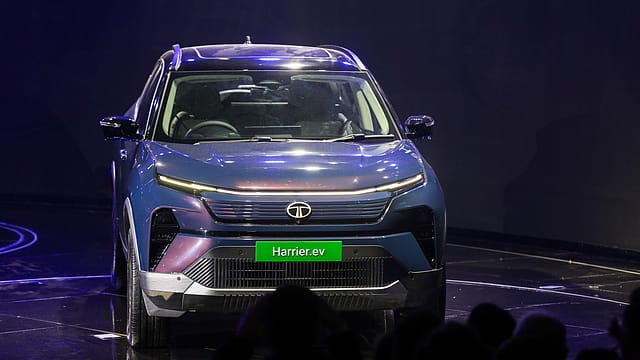Tata Motors plans to invest up to ₹35,000 crore, double portfolio to 15 cars by FY30
ADVERTISEMENT

Tata Motors plans to invest between ₹33,000 and ₹35,000 crore in the next five years and plans to have more than 15 products in its portfolio by FY30, according to its Investor Day presentation. It plans to launch seven new products, along with 23 facelifts and refreshes.
It envisions a 16% market share by FY27, including EVs, and an 18-20% market share in the next two to three years. For EVs, it expects a penetration of 20% by FY27, and more than 30% by FY30. Tata Motors’ EV business is also well-funded for the next three years.
The homegrown carmaker also aspires to deliver 10% EBITDA for its consolidated passenger vehicle (PV) and electric vehicle (EV) businesses by FY30, according to its Investor Day presentation. The homegrown carmaker also said that it aspires to deliver free cash flow (FCF) for its consolidated PV and EV businesses around the same period. The PV business is expected to deliver an FCF of more than ₹1,000 crore, whereas the EV business is expected to be FCF negative in the medium term.
December 2025
The annual Fortune 500 India list, the definitive compendium of corporate performance, is out. This year, the cumulative revenue of the Fortune 500 India companies has breached $2 trillion for the first time. Plus, find out which are the Best B-schools in India.
In the presentation, Tata Motors also said it expects short-term fluctuations in the industry, but secular growth in the passenger vehicle industry will persist, growing to six million units by FY30. Currently, the demand is in moderation with a modest 2% growth after three years of strong growth. It is also expecting seasonally high stock levels as the overall market demand is expected to be muted.
The key drivers for this growth, according to the carmaker, include a rapid growth in high consumption households, growing per capita penetration of PVs—in line with the growing GDP numbers—and a faster replacement cycle of new models, which is currently at four years.
By FY30, SUVs will make up for 60% of the sales volume in the PV industry, according to an estimate that the carmaker shared in the presentation, followed by hatchbacks at 20%, declining more than half from 47% in FY20, and MPVs at 11%. The market share of sedans, on the other hand, is going to halve to 7% in FY30 from 14% in FY20.
“The majority of new launches will be focused on SUVs, and newer styles—coupes and crossovers, for instance—are likely to gain customer traction,” reads the presentation. It also adds that MPVs are likely to grow sharply. “The product offerings are likely to increase. There is a growing appeal for MPVs as a family vehicle”.
Tata Motors witnessed an 11% year-on-year growth in its SUV segment to 4.33 lakh units in FY25. It also claims the Tata Punch was the number one model in the industry in 2024. During the year, Tata Motors introduced the Curvv, India’s first coupe SUV, and witnessed a sustained demand for its Nexon SUV, selling more than 1.5 lakh units in FY25.
Hatchbacks, on the other hand, will see their market share taper in the coming years due to their higher entry prices, due to which potential buyers find better value in used cars, and a paucity of newer launches. According to the carmaker, the ageing products in its hatchback segment—namely the Altroz and the Tiago—resulted in stress on customer traction. It says that the Tiago 2025 refresh in the fourth quarter and the Altroz mid-cycle enhancement are expected to drive revival in demand.
In the past year, Tata Motors has also seen its market share in EVs decline sharply from 73% in FY24 to 55% in FY25 and compared to 87% in FY22. While industry reports have highlighted the rise of JSW MG Motor India with the success of its Windsor EV, the carmaker claims that the headwinds it faced were industry-specific, namely the expiry of the FAME II incentive for fleet EVs and muted growth during the first half of the year due to global negativity on EVs. CNG, on the other hand, has also witnessed healthy growth of 53% year-on-year, selling 1.39 lakh units in FY25. The launch of Nexon CNG has enabled the company to target new customer segments, making it a key driver of growth.
For EVs deployed in fleets, Tata Motors diversified its fleet ownership to smaller players in the industry, with 67% of the commercial EVs currently deployed to mid or small-size players, compared to 35% in FY24. The rest is deployed to five major operators, which were 65% in FY24.
